RFID In Pharmaceuticals Market Size
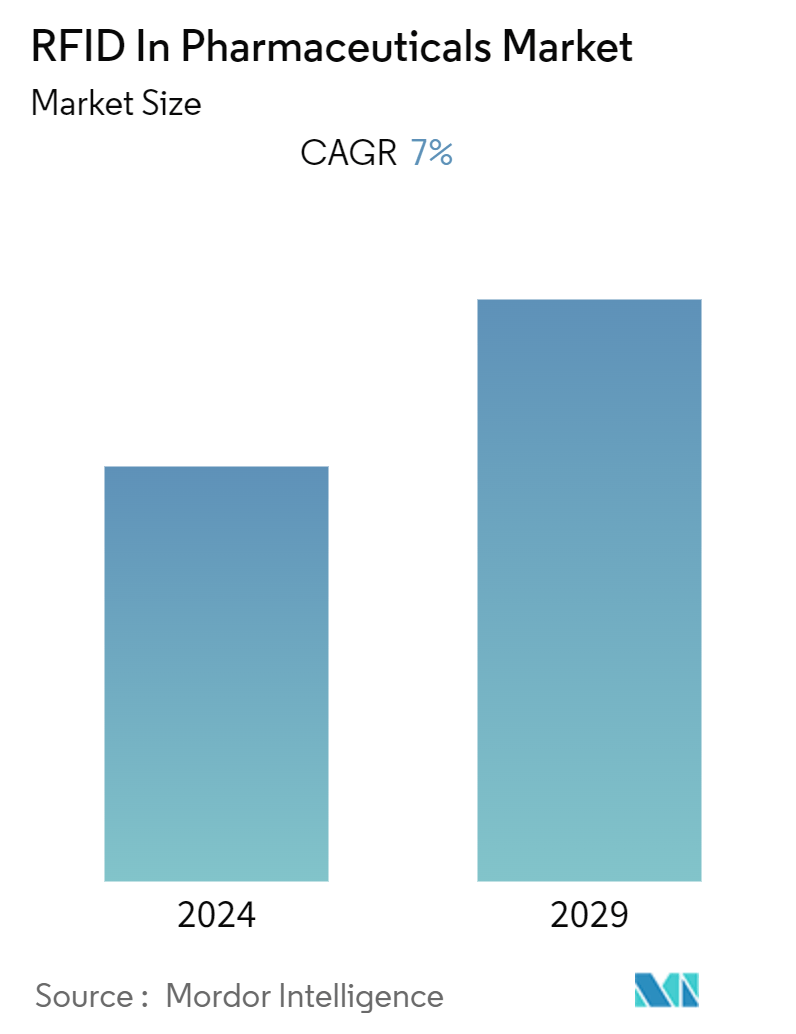
| Study Period | 2021 - 2029 |
| Base Year For Estimation | 2023 |
| CAGR (2024 - 2029) | 7.00 % |
| Fastest Growing Market | Asia-Pacific |
| Largest Market | North America |
| Market Concentration | Low |
Major Players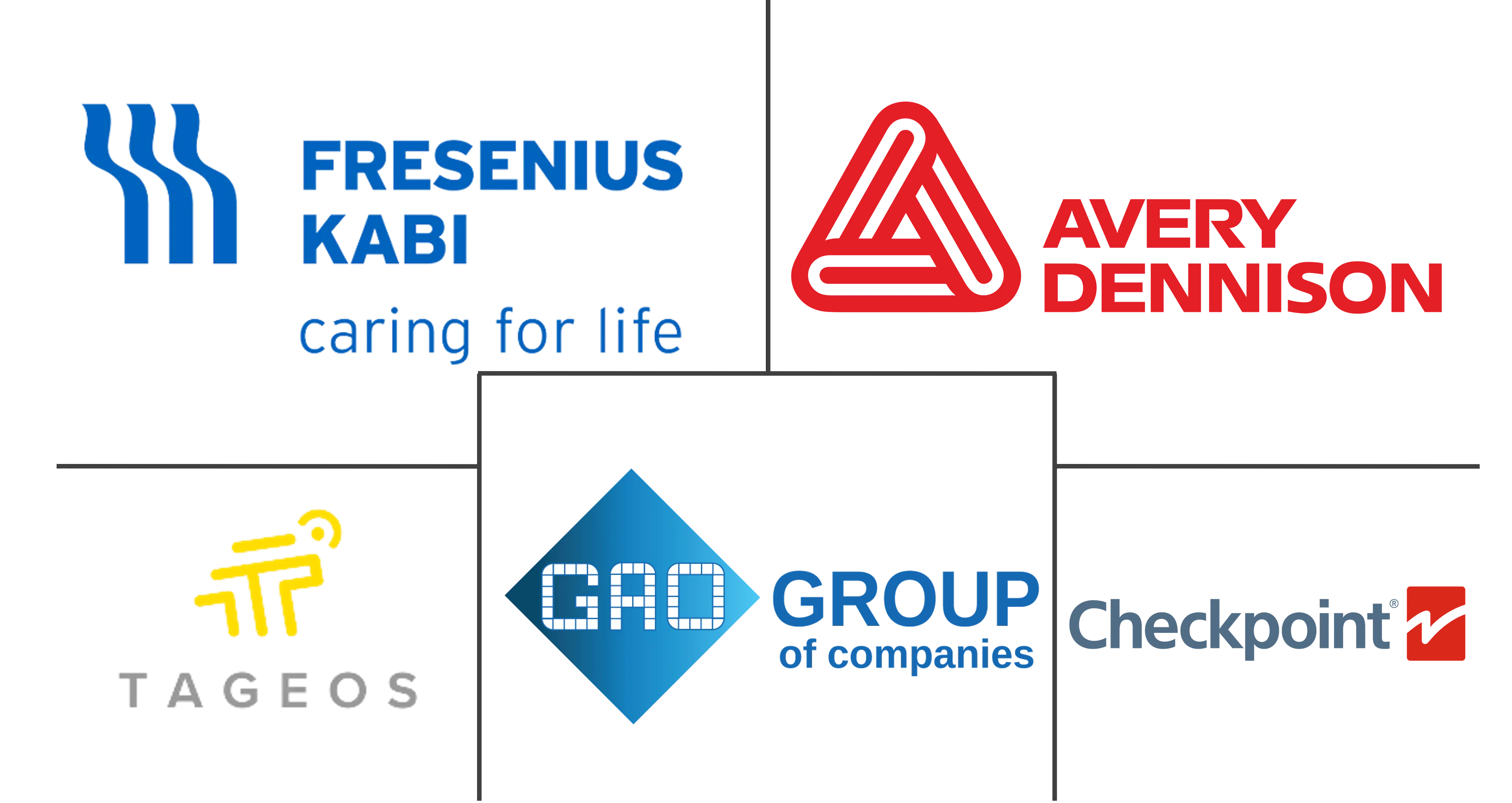
*Disclaimer: Major Players sorted in no particular order |
RFID In Pharmaceuticals Market Analysis
The RFID In Pharmaceuticals Market is expected to register a CAGR of 7% during the forecast period.
The increasing adoption of RFID technology in healthcare is expected to boost market growth, enabling real-time drug tracking, tracing, and authentication in the pharmaceutical industry. For instance, a report published by Diagnostyka Journal in August 2022 highlighted the maturation of applications such as real-time locating systems (RTLS) for patient tracking, medical personnel, and asset tracking, which is expected to contribute to rapid expansion in the RFID industry in the coming years.
Moreover, novel product launches by key market players drive the market's growth. For instance, in November 2022, Schreiner MediPharm and SCHOTT Pharma launched prefilled syringes with RFID labels, enabling enhanced tracking and monitoring of medication usage.
Similarly, in February 2022, Avery Dennison Smartrac developed the AD Minidose U9 RAIN RFID inlay specifically for pharmaceutical applications, which offers improved inventory management and supply chain visibility for healthcare, pharmacies, and laboratory asset management.
Additionally, in October 2023, Fresenius Kabi launched its +RFID smart labels for Diprivan (Propofol) injectable emulsion, USP, 200mg per 20ml in single-dose vials. These smart labels are compatible with all major radio-frequency identification (RFID) kits and tray systems. The introduction of innovations, technological advancements, and the rising need for efficient supply chain management are all projected to fuel market growth.
However, the high cost of installing an RFID system may hinder the market's growth. Despite this, the aforementioned factors, including the rising adoption of RFID technology and the rising prevalence of counterfeit drugs, are expected to boost market growth.
RFID In Pharmaceuticals Market Trends
Drug Tracing Systems Segment Expected to Register a Significant CAGR Over the Forecast Period
The pharmaceutical industry has increasingly turned to RFID technologies to enhance visibility across the value chain and track falsified drugs. The escalating incidents of counterfeit drugs and drug recalls have compelled governments to reframe drug quality regulations and implement strict measures, making QR codes or RFID tags mandatory on active pharmaceutical ingredients and products for safety and tracking purposes. This trend is expected to drive the growth of RFID in drug tracing systems in the coming years.
For instance, an article published by the National Center for Biotechnology Information in 2022 reported that Valsartan, a long-term medication used in patients with high blood pressure and heart disease, was recalled due to contamination with N-nitroso dimethylamine (NDMA), a potential cancerogenic substance resulting from unintended changes in the manufacturing process in China. This highlights the pressing need for stringent quality control measures in the pharmaceutical industry to prevent the circulation of counterfeit and dangerous drugs, which is expected to boost the demand for RFID technologies in drug tracing and tracking systems.
Similarly, an article published by Forensic Science International Journal in September 2022 reported that counterfeit, fake, adulterated, or falsified drugs and pharmaceuticals could be branded or generic drugs, excipients, and active substances (in drugs and vaccines). The trafficking of counterfeit drugs has continued to increase in the last decade, contributing to the rising demand for RFID technologies to combat this problem.
The introduction of next-generation RFID tags and readers has enabled drug manufacturers and wholesalers in the pharmaceutical industry to prevent medical errors and increase the safety of individualized medicinal products. According to an article published by SpringerLink in August 2022, RFID technology can be used to overcome the black market problem of counterfeiting drugs or as a prevention tool. This further highlights the potential of RFID technologies in enhancing drug tracing and tracking systems.
Therefore, with the increasing number of counterfeit drugs and the growing adoption of advanced RFID technology, the segment is anticipated to witness significant growth over the forecast period.
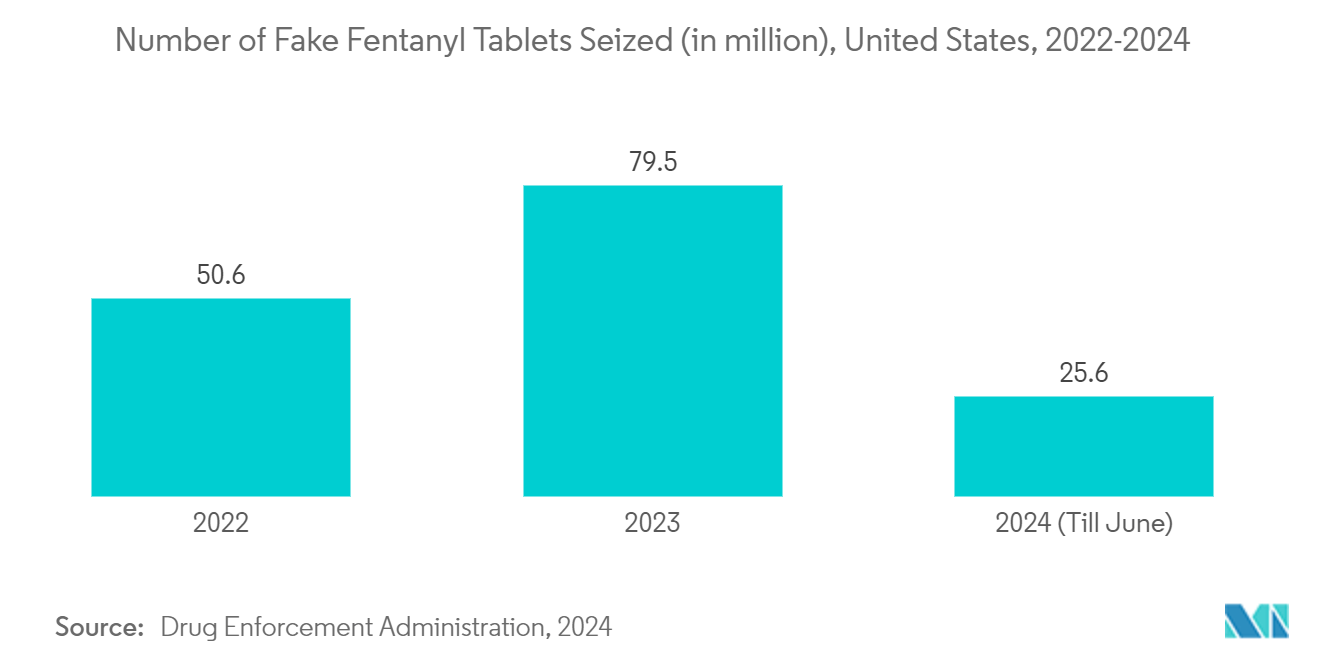
North America is Expected to Register Significant Market Share Over the Forecast Period
North America is expected to grow at a significant rate in the market share during the forecast period, mainly due to the increasing prevalence of substandard and falsified drugs and stringent regulatory frameworks. The rising incidences of drug counterfeiting within large pharmaceutical and biopharmaceutical companies have emerged as a key driver for the growth of RFID technology in the pharmaceutical market.
For instance, in August 2022, Health Canada inspectors seized counterfeit erectile dysfunction drugs, including Viagra and Cialis, from a store in Scarborough, Ontario, Canada. These incidents are expected to further boost the demand for RFID in the pharmaceutical market in the region.
Significant advancements in RFID technologies and systems have also contributed to the market's growth. For instance, in November 2022, a membership-driven industry alliance that advances RFID technology in pharmaceuticals rebranded to UnitVisID Alliance as the new name for the DoseID Consortium in the United States.
Similarly, in August 2022, Kit Check, the leading automation vendor in Medication Intelligence, informed that its proprietary Radio Frequency Identification (RFID) technology was incorporated in the new KinetiX Propofol syringes being developed by Genixus, a pharmaceutical company and FDA-registered repackager and 503B outsourcing provider focused on transforming acute and critical care medicines.
Therefore, the market is expected to experience substantial growth during the forecast period due to the abovementioned factors, including the rising number of counterfeit drugs and key developments by organizations in the market.
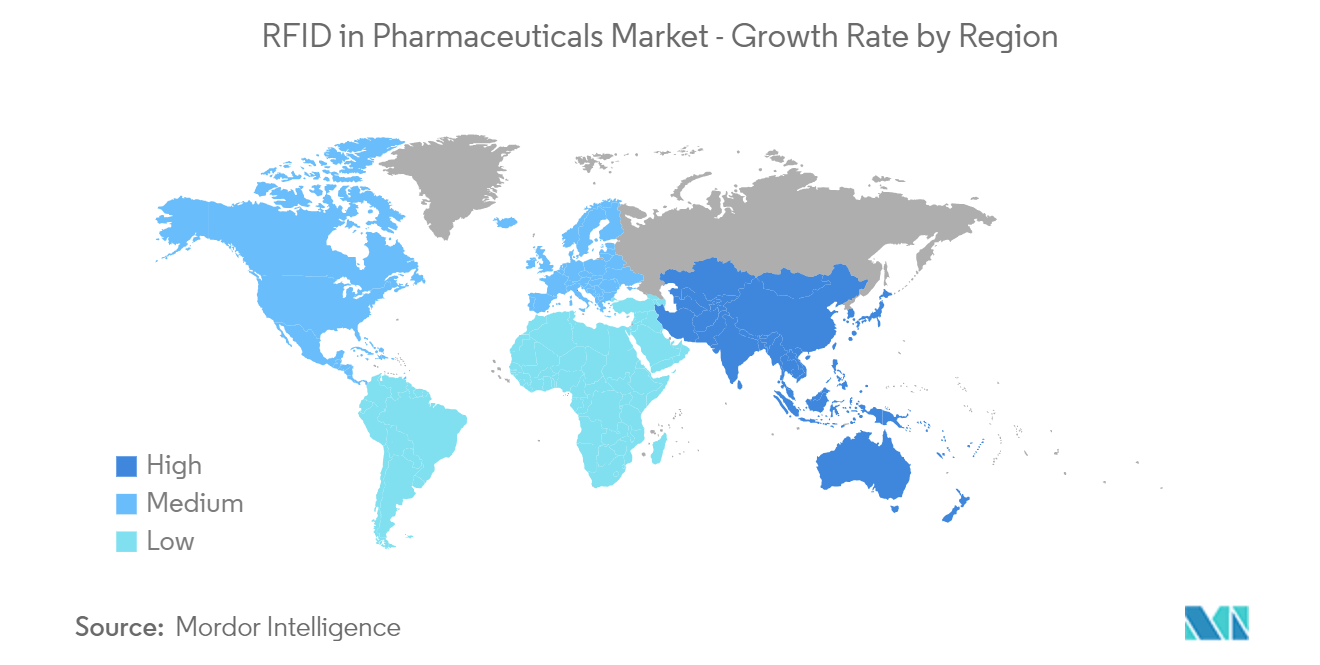
RFID In Pharmaceuticals Industry Overview
RFID technology in the pharmaceutical market is characterized by fragmentation. Several RFID technology providers are currently concentrating on developing innovative products and advancing their technology to expand their global market reach and increase their market share. Key players in the industry include Checkpoint Systems Inc., Avery Dennison Corporation, Tageos, and Fresenius Kabi.
RFID In Pharmaceuticals Market Leaders
-
Checkpoint Systems, Inc.
-
GAO Group
-
Tageos
-
Fresenius Kabi
-
Avery Dennison Corporation
*Disclaimer: Major Players sorted in no particular order
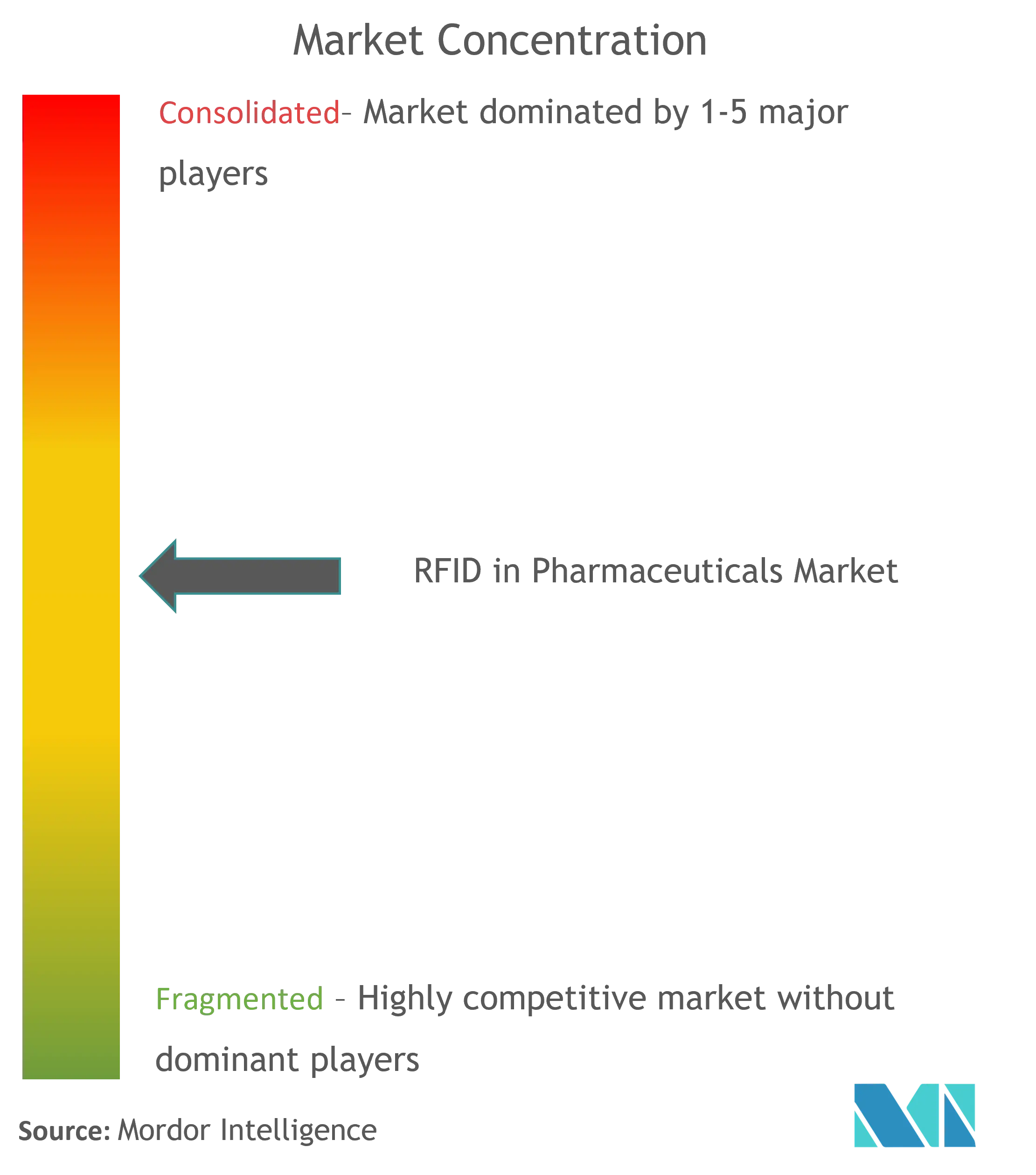
RFID In Pharmaceuticals Market News
- April 2024: Schreiner MediPharm launched late-stage customization for RFID labels, enabling sophisticated smart labels to be supplied on short notice and order-specific programming of the integrated RFID chip.
- April 2024: ProMach acquired Etiflex, a pressure-sensitive and RFID label producer. The addition of Etiflex expanded ProMach’s labeling and coding capabilities throughout North America.
RFID in Pharmaceuticals Market Report - Table of Contents
1. INTRODUCTION
- 1.1 Study Assumption and Market Definition
- 1.2 Scope of the Study
2. RESEARCH METHODOLOGY
3. EXECUTIVE SUMMARY
4. MARKET DYNAMICS
- 4.1 Market Overview
-
4.2 Market Drivers
- 4.2.1 Rising Prevalence of Counterfeit Drugs
- 4.2.2 Introduction of Innovations and Advanced Technology
- 4.2.3 Adoption of RFID by Pharmaceutical Industry
-
4.3 Market Restraints
- 4.3.1 High Cost of RFID System Installation
-
4.4 Porter's Five Forces Analysis
- 4.4.1 Threat of New Entrants
- 4.4.2 Bargaining Power of Buyers/Consumers
- 4.4.3 Bargaining Power of Suppliers
- 4.4.4 Threat of Substitute Products
- 4.4.5 Intensity of Competitive Rivalry
5. MARKET SEGMENTATION (Market Size by Value - in USD)
-
5.1 By Component
- 5.1.1 RFID Readers
- 5.1.2 RFID Tags
- 5.1.3 RFID Middleware
-
5.2 By Type
- 5.2.1 Chipped RFID
- 5.2.2 Chipless RFID
-
5.3 By Application
- 5.3.1 Drug Tracing Systems
- 5.3.2 Drug Quality Management
- 5.3.3 Other Applications
-
5.4 By End User
- 5.4.1 Drug Manufacturers
- 5.4.2 Hospitals and Clinics
- 5.4.3 Other End Users
-
5.5 By Geography
- 5.5.1 North America
- 5.5.1.1 United States
- 5.5.1.2 Canada
- 5.5.1.3 Mexico
- 5.5.2 Europe
- 5.5.2.1 Germany
- 5.5.2.2 United Kingdom
- 5.5.2.3 France
- 5.5.2.4 Italy
- 5.5.2.5 Spain
- 5.5.2.6 Rest of Europe
- 5.5.3 Asia-Pacific
- 5.5.3.1 China
- 5.5.3.2 Japan
- 5.5.3.3 India
- 5.5.3.4 Australia
- 5.5.3.5 South Korea
- 5.5.3.6 Rest of Asia-Pacific
- 5.5.4 Middle East and Africa
- 5.5.4.1 GCC
- 5.5.4.2 South Africa
- 5.5.4.3 Rest of Middle East and Africa
- 5.5.5 South America
- 5.5.5.1 Brazil
- 5.5.5.2 Argentina
- 5.5.5.3 Rest of South America
6. COMPETITIVE LANDSCAPE
-
6.1 Company Profiles
- 6.1.1 Checkpoint Systems Inc.
- 6.1.2 GAO Group
- 6.1.3 AVERY DENNISON CORPORATION
- 6.1.4 Tageos
- 6.1.5 Fresenius Kabi
- 6.1.6 Invengo Technology Pte Ltd
- 6.1.7 Zebra Technologies Corporation
- 6.1.8 CCL Industries
- 6.1.9 Blue Vector
- 6.1.10 Intermec Inc.
- *List Not Exhaustive
7. MARKET OPPORTUNITIES AND FUTURE TRENDS
** Subject To AvailablityRFID In Pharmaceuticals Industry Segmentation
As per the scope of the report, RFID (radio-frequency identification) is a technology that uses electromagnetic fields to identify and track tags attached to objects automatically. The RFID in pharmaceuticals market is segmented by component, application, type, and geography. The component segment is further divided into RFID readers, RFID tags, and RFID middleware. The application segment is further bifurcated into chipped RFID and chipless RFID. The type segment is further segmented into drug tracing systems, drug quality management, and other types. The geography segment is further segmented into North America, Europe, Asia-Pacific, Middle-East and Africa, and South America. The market report also covers the estimated market sizes and trends for 17 countries across major regions globally. The report offers the value (USD) for the above segments.
| By Component | RFID Readers | |
| RFID Tags | ||
| RFID Middleware | ||
| By Type | Chipped RFID | |
| Chipless RFID | ||
| By Application | Drug Tracing Systems | |
| Drug Quality Management | ||
| Other Applications | ||
| By End User | Drug Manufacturers | |
| Hospitals and Clinics | ||
| Other End Users | ||
| By Geography | North America | United States |
| Canada | ||
| Mexico | ||
| By Geography | Europe | Germany |
| United Kingdom | ||
| France | ||
| Italy | ||
| Spain | ||
| Rest of Europe | ||
| By Geography | Asia-Pacific | China |
| Japan | ||
| India | ||
| Australia | ||
| South Korea | ||
| Rest of Asia-Pacific | ||
| By Geography | Middle East and Africa | GCC |
| South Africa | ||
| Rest of Middle East and Africa | ||
| By Geography | South America | Brazil |
| Argentina | ||
| Rest of South America |
RFID in Pharmaceuticals Market Research FAQs
What is the current RFID In Pharmaceuticals Market size?
The RFID In Pharmaceuticals Market is projected to register a CAGR of 7% during the forecast period (2024-2029)
Who are the key players in RFID In Pharmaceuticals Market?
Checkpoint Systems, Inc., GAO Group, Tageos, Fresenius Kabi and Avery Dennison Corporation are the major companies operating in the RFID In Pharmaceuticals Market.
Which is the fastest growing region in RFID In Pharmaceuticals Market?
Asia-Pacific is estimated to grow at the highest CAGR over the forecast period (2024-2029).
Which region has the biggest share in RFID In Pharmaceuticals Market?
In 2024, the North America accounts for the largest market share in RFID In Pharmaceuticals Market.
What years does this RFID In Pharmaceuticals Market cover?
The report covers the RFID In Pharmaceuticals Market historical market size for years: 2021, 2022 and 2023. The report also forecasts the RFID In Pharmaceuticals Market size for years: 2024, 2025, 2026, 2027, 2028 and 2029.
RFID in Pharmaceuticals Industry Report
Statistics for the 2024 RFID in Pharmaceuticals market share, size and revenue growth rate, created by Mordor Intelligence™ Industry Reports. RFID in Pharmaceuticals analysis includes a market forecast outlook 2029 and historical overview. Get a sample of this industry analysis as a free report PDF download.



